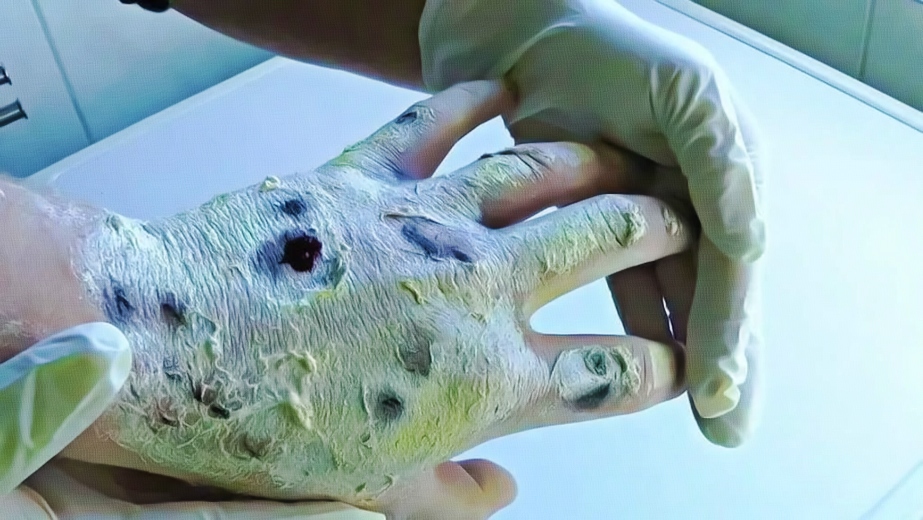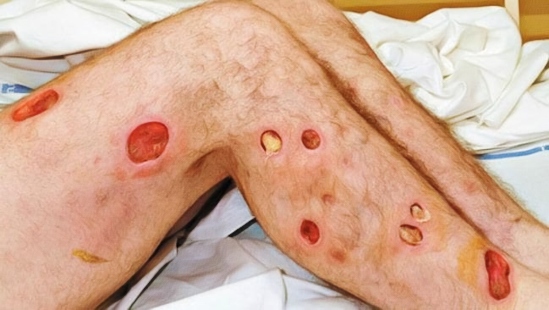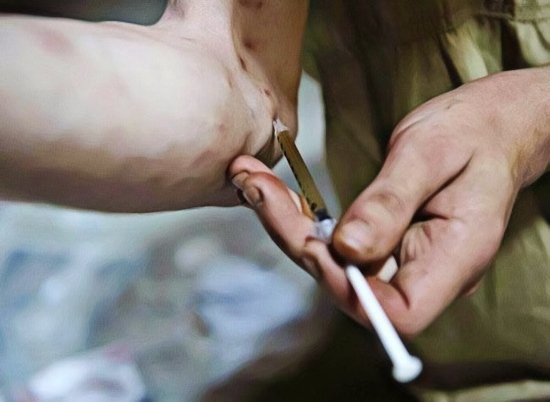However, krokodil is mostly known for its severe and undesirable side effects.
Krokodil Effects
The most common complications reported from krokodil injection is serious damage to the skin, blood vessels, bone, and muscles. It can present similarly to other dermatological skin diseases such as necrotizing fasciitis, also known as flesh-eating disease, or pyoderma gangrenosum, which is a rare condition that causes large, painful sores to develop on the skin.
There are reports of skin grafts and limb amputation in long-term users due to the severity of the tissue damage.

Also, researchers have observed that depending on the type of toxic additives that were in the krokodil drug, different effects are noticed. For example, if red phosphorous (matchbook striking surface) is present that can cause damage to cartilage tissue and bones. Researchers have also found that it can cause atypical jaw osteomyelitis, where the bone marrow in the jaw becomes inflamed.
Krokodil effects on skin
One of the more reported effects of krokodil is the scaly, black, and green skin that resembles crocodile skin – which is rumored to be the reason behind the drug’s name.
In krokodil users, there are reports of the skin becoming swollen and inflamed around the injection site. Additionally, blood vessels are often damaged and the surrounding skin can develop sores or abscesses and get infected. In some reports, users develop gangrene, which is characterized by the scaly, green-black skin discoloration.
Research notes that krokodil seems to be more associated with gangrenous and necrotic tissue destruction than other intravenously injected illicit substances, including heroin.
The skin tissue effects of krokodil usually occur at the drug injection site but can also appear on other parts of the body, such as the skull and forehead.

Depending on the level of severity, the skin can fall from the bone (necrosis) giving a “zombie-like” appearance. In the U.S. the drug became known as the “flesh-eating drug” due to the extreme skin peeling associated with its use.
These effects are said to happen quite soon after the use of krokodil. It is also thought that the complications are because of the toxic solvents, like battery acid, that’s added when cooking krokodil, not the desomorphine or codeine itself.
However, the true mechanics of skin deterioration is unknown.
Other health hazards from krokodil
- Open ulcers and abscesses
- Blood poisoning
- Meningitis
- Bone infections (osteomyelitis) and bone death (osteonecrosis)
- Speech and motor skill impairment
- Rotting gums and tooth loss
- Blood-borne virus transmission (such as HIV and HCV due to needle sharing)
- Memory loss and impaired concentration
- Liver and kidney damage
- Pneumonia
- Respiratory problems (slowed or stopped breathing)
- Organ or central nervous system damage
- Death
Animal studies in rats, where the rat’s received daily doses of desomorphine have also shown to have side effects of heart congestion and kidney toxicity.
Krokodil withdrawal effects
Krokodil withdrawal effects are similar to other opioid withdrawal symptoms. They can include irritability, tremors, hypertension, nausea, vomiting, and hyperthermia.
However, unlike other opioid withdrawal effects that typically last a week, krokodil withdrawal effects can last up to a month.

“With heroin withdrawal, the main symptoms last for five to 10 days. After that, there is still a big danger of relapse but the physical pain will be gone. With krokodil, the pain can last up to a month, and it’s unbearable. They have to be injected with extremely strong tranquilizers just to keep them from passing out from the pain,” Artyom Yegorov, a doctor who works at a Russian drug treatment center, told the Independent in an interview.
Long-term krokodil drug effects
Little is known about the long-term effects of krokodil as most users don’t live longer than two or three years after starting to use the drug.
Sources:
https://time.com/3398086/the-worlds-deadliest-drug-inside-a-krokodil-cookhouse/
https://www.bhpalmbeach.com/blog/authorities-wary-designer-drug-krokodil-appears-american-streets/
https://www.deadiversion.usdoj.gov/drug_chem_info/desomorphine.pdf
https://www.ncbi.nlm.nih.gov/pmc/articles/PMC4864092/
https://pubmed.ncbi.nlm.nih.gov/25710781/
https://pubmed.ncbi.nlm.nih.gov/23726898/
https://pharmacy.hsc.wvu.edu/media/1315/krokodil-a-new-drug-of-abuse.pdf

